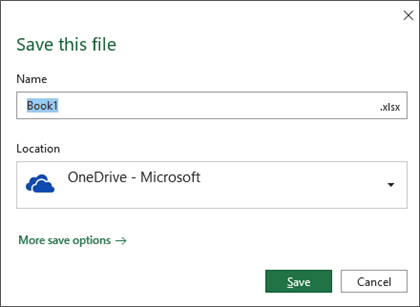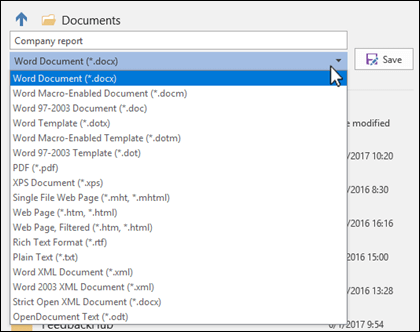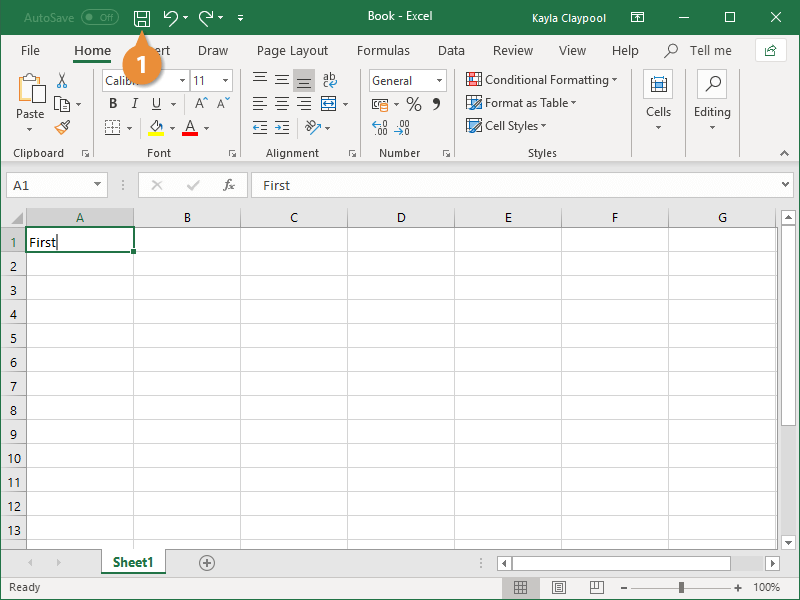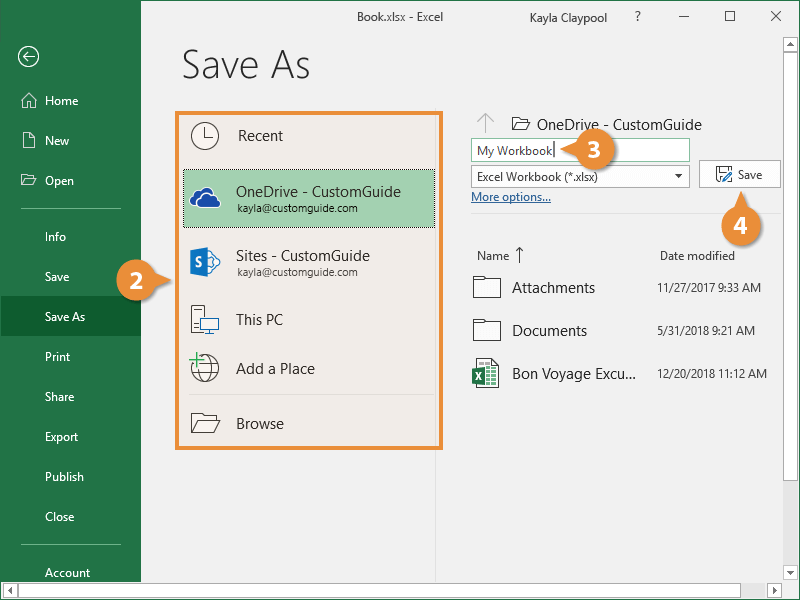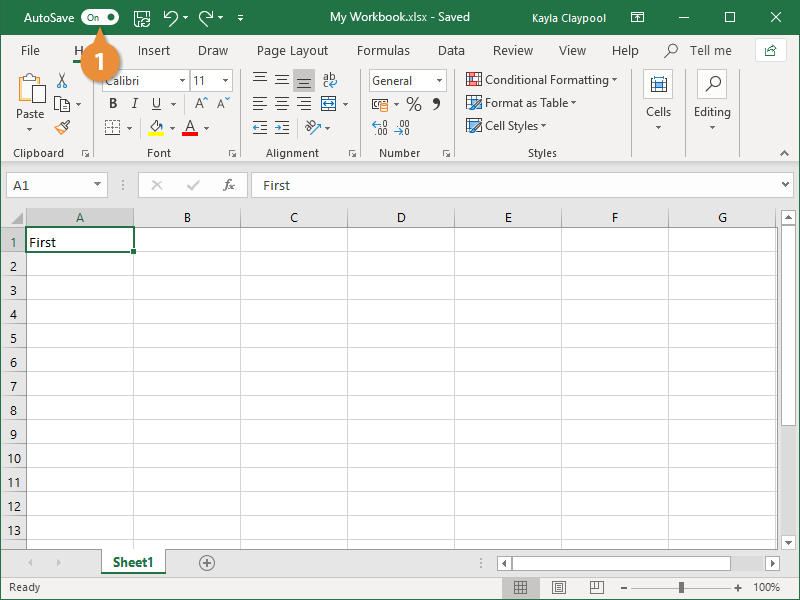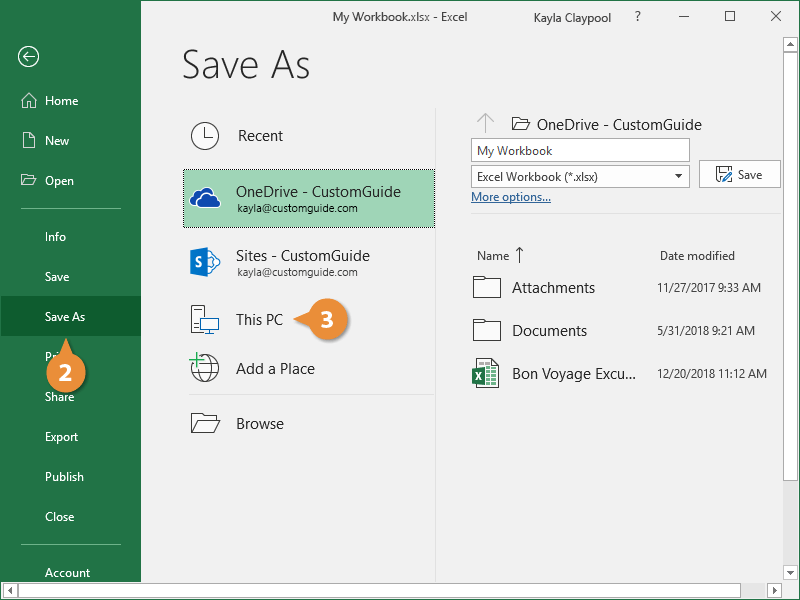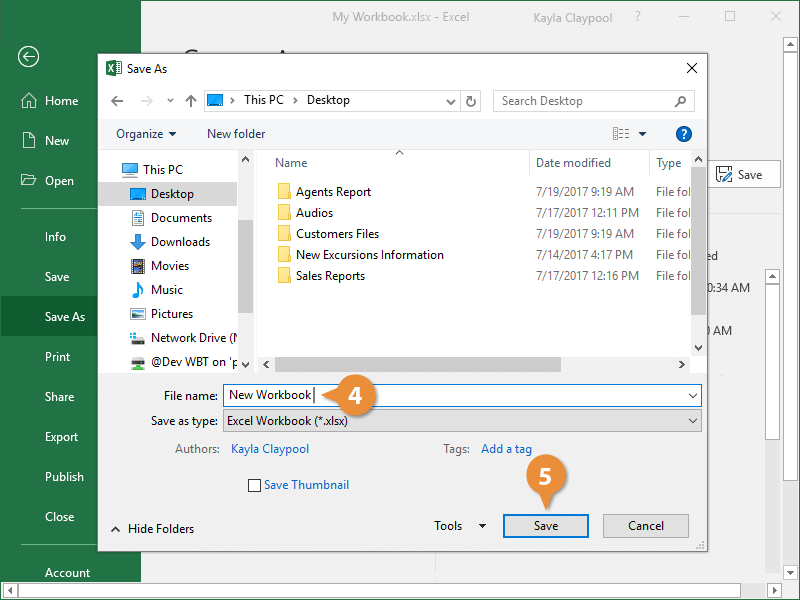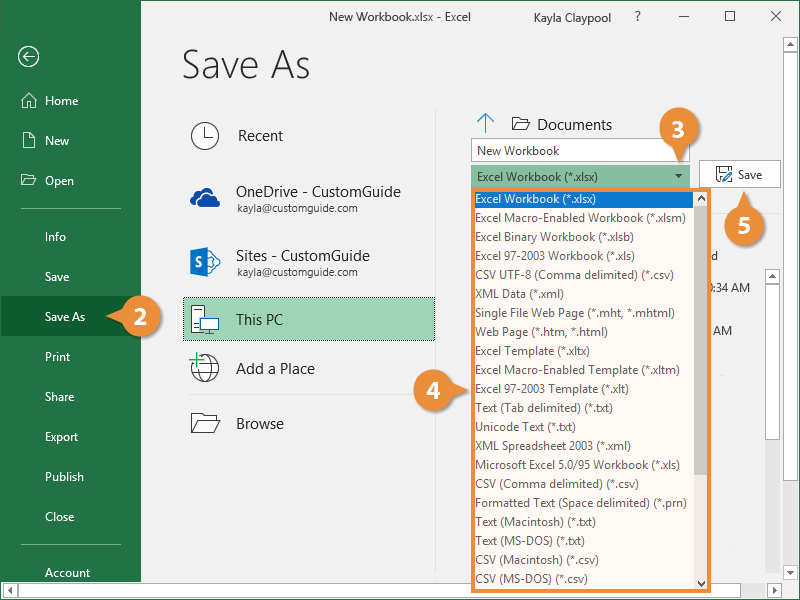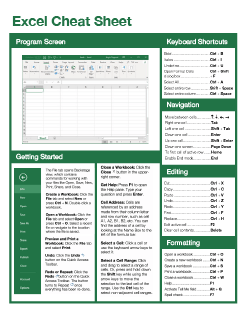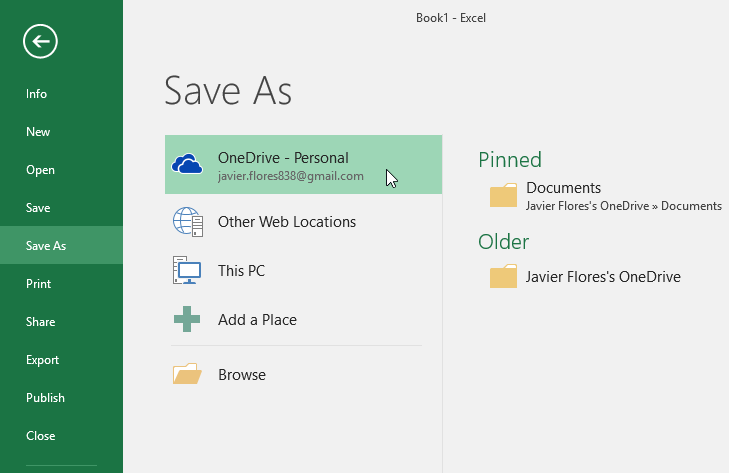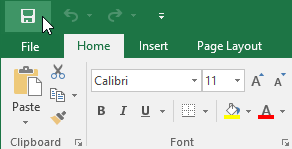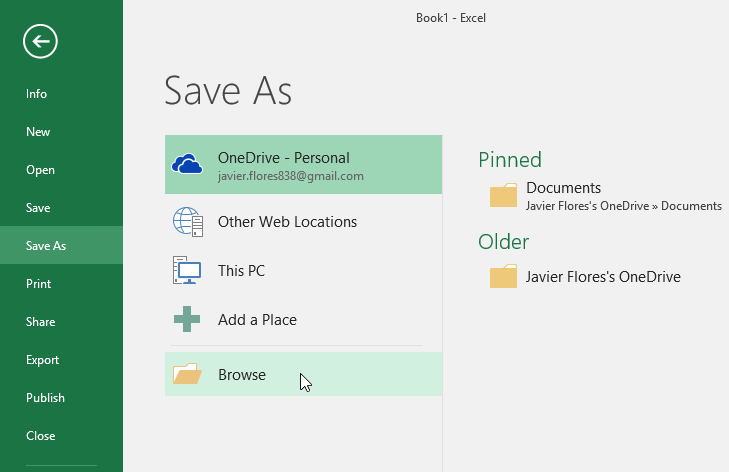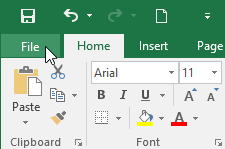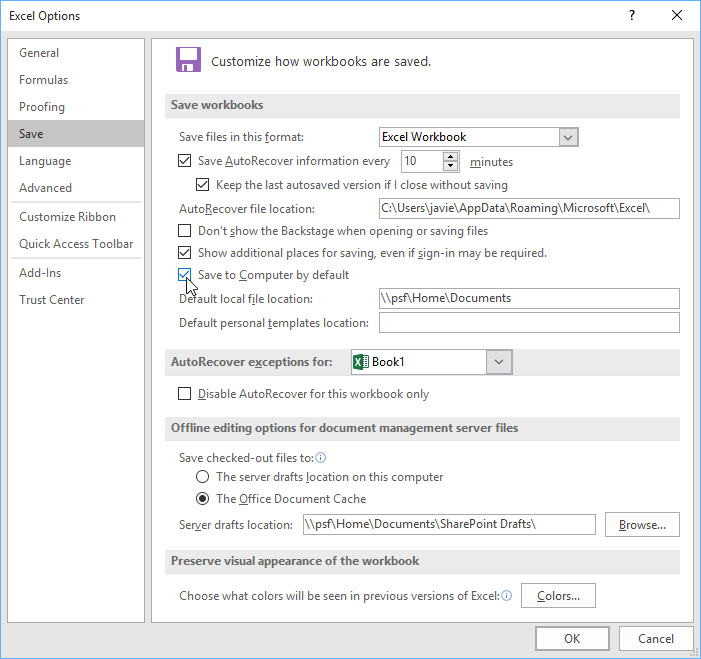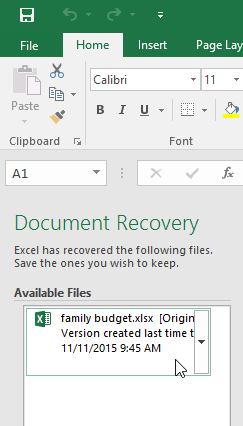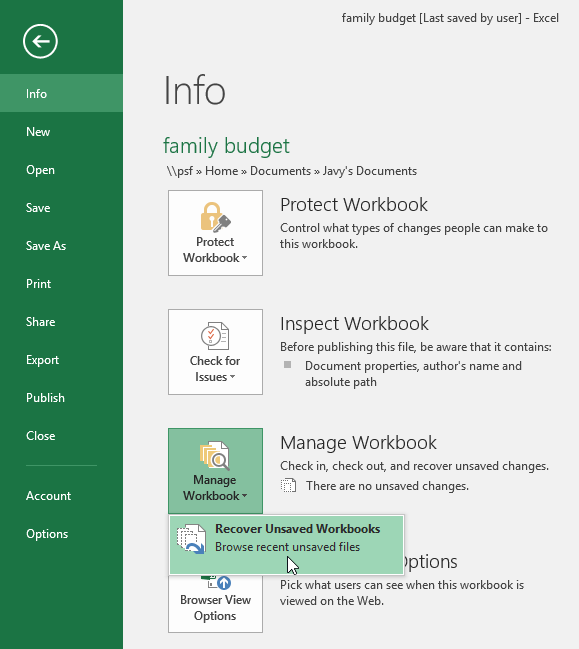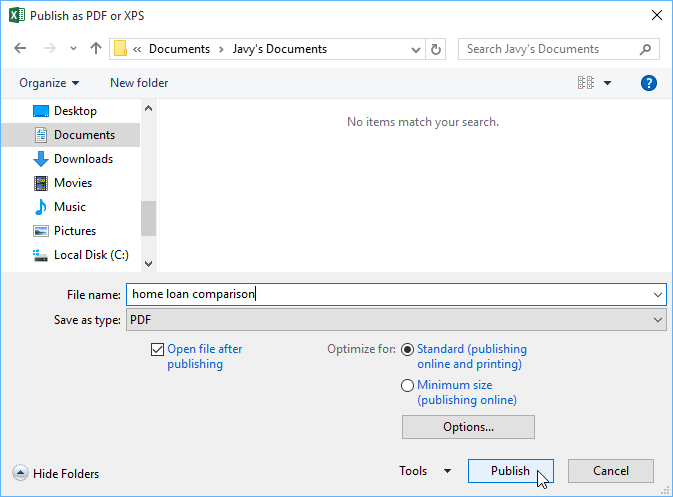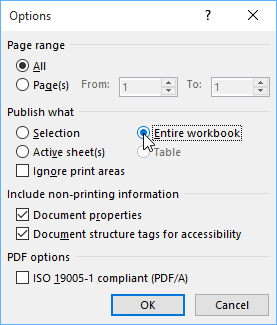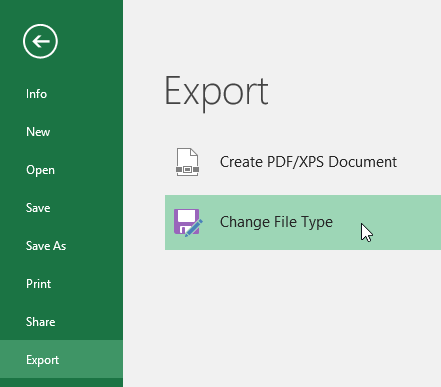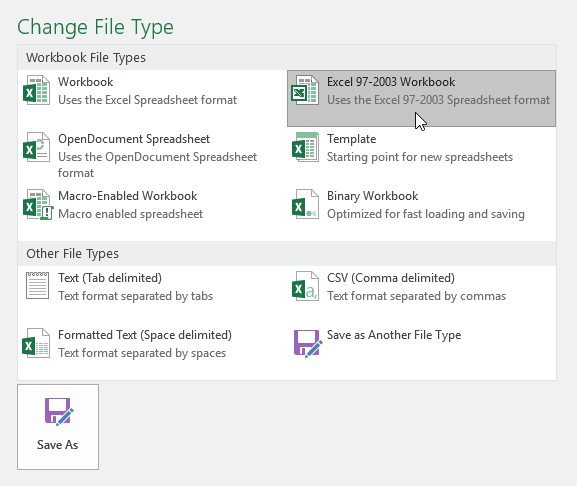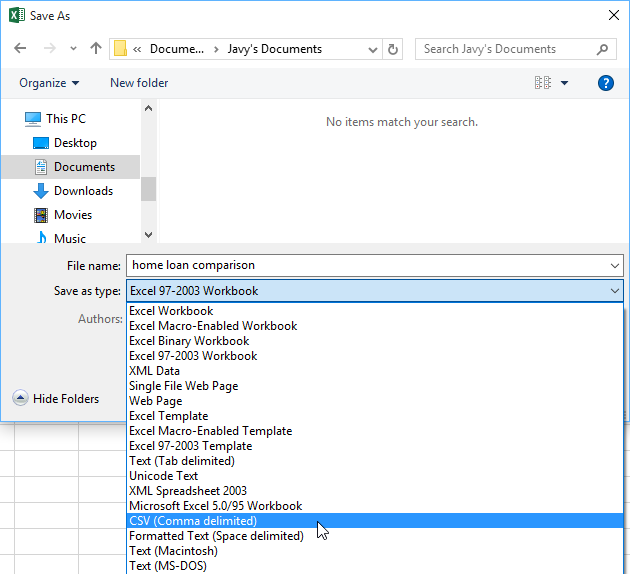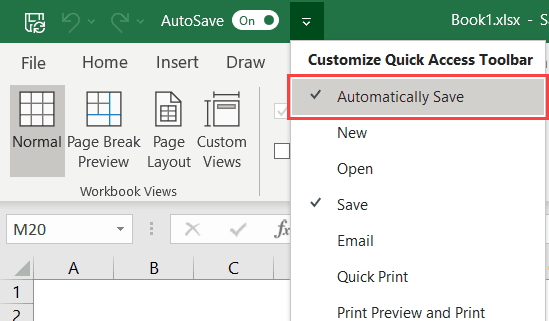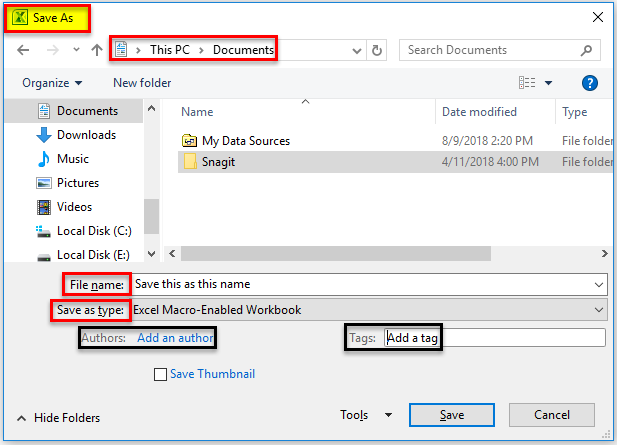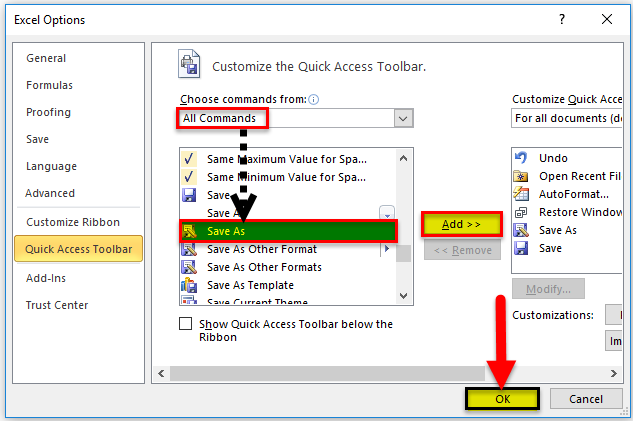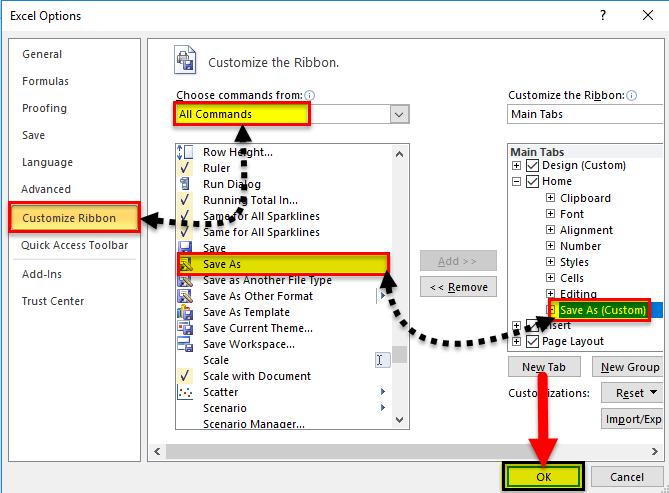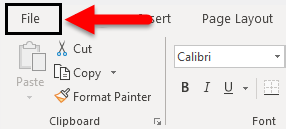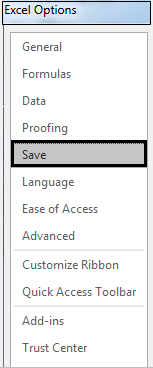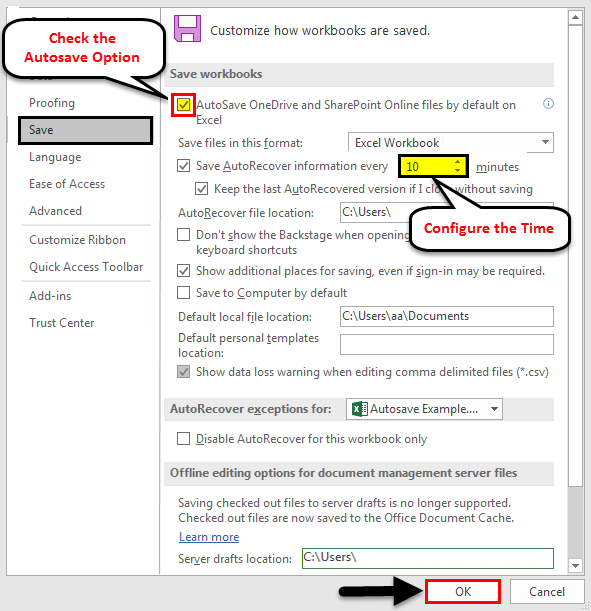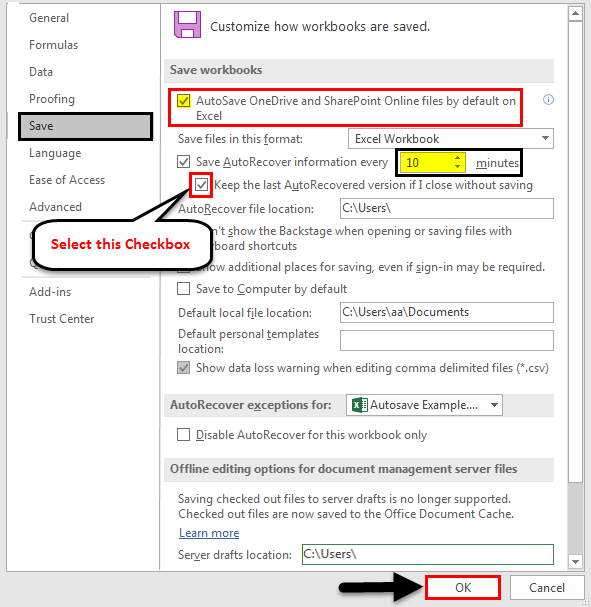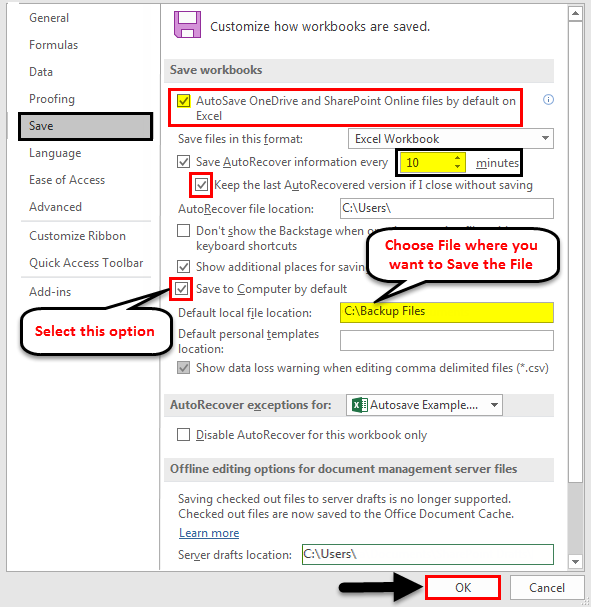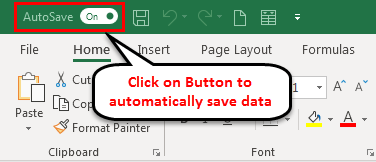You can save a file to a folder on your hard disk drive, a network location, the cloud, a DVD, the desktop, or a flash drive. While you must identify the destination, if it is different than the default folder, the saving process is the same regardless of what destination you choose. By default, Microsoft 365 programs save files in the default working folder.
Additionally you can save a file in a different file format, such as RTF, CSV, or PDF.
Saving a file to OneDrive or SharePoint allows you to access it on any device and enables features such as AutoSave and Version History, which can help prevent data loss if your file closes unexpectedly.
To save your file:
-
Press CTRL+S or select File > Save.
Tip: You can also select Save
on the Quick Access Toolbar.
-
You must enter a name for the file if you are saving it for the first time.
Tip: Save your file to a cloud location, such as OneDrive or SharePoint, to be able to access it anywhere, collaborate with others in real-time, and access Version History.
By default, if you’re signed in, files are saved to your OneDrive. If you want to save the current file somewhere else, click the Location drop-down to see additional recently-used locations. If the location you want isn’t there, you can open the full Save As window by selecting More save options.
Tip: If you save your file to OneDrive or SharePoint, AutoSave will be enabled by default, so you don’t have to remember to save as you go.
If you’d like to change the default location for these saves to one of your other recently-used folders, select the Location drop-down, right-click the folder location you want to set as the default and select Set as Default Location.

If you want to save to a location other than your recently-used folders, select More locations. If you haven’t received this update yet, your Office applications will continue to use the File menu for saving.
Tips:
-
You can also press F12 or select File > Save As to open the File menu.
-
If you’re used to using keyboard shortcuts when closing your document, such as ALT+F4, you can quickly choose to «Don’t Save» the file by using the keyboard accelerator key for that button (ALT+N).
Save a copy as a new file (Save As)
Tip: If you’re going to create a new file based on an existing file, but only want your changes saved in the new file, it’s a good idea to Save a Copy before you’ve made any changes. That way your original file will remain unchanged and all your edits will be in the new copy. You can also right-click the original file and select Open a copy.
-
Press F12 or click File > Save a Copy
-
By default Office will save the copy in the same location as the original. If you’re happy with the existing location go on to step 3. If you want to save the new copy in a different location choose it at this point.
Location
Description
Sites –
[Your Company Name]
SharePoint or Office 365 Groups document libraries
OneDrive –
[Your Company Name]
OneDrive for Business
OneDrive – Personal
OneDrive for consumers via your Microsoft account
This PC
Your local device, including any connected hard drives or flash drives
Browse
Opens the File Explorer so you can navigate to any location on your computer.
-
Give your new copy a name and click Save.
Your original file will be closed and you’ll now be working in the new copy you just created.
Tip: If you find yourself creating new files based on existing files often, you may want to use templates to make the process easier and safer. See Create a template for more information.
Save as a different format
You might want to save your file in another format so that you, or somebody else, can open the file in a different program or older version. For example, you might want to save your Word document as a Rich Text File (RTF) or your Excel workbook as a Comma-Separated Values (CSV) file.
Important: If you save an Office file in a format other than the Open XML format (such as .DOCX, .XLSX, or .PPTX) some connected experiences and modern features like AutoSave or Accessibility Checker won’t work on that file.
-
Click the File tab.
-
Click Save As.
-
Choose a file location, such as OneDrive or This PC to store your file.
-
In the File name box, enter a new name for the file.
-
In the Save as type list, click the file format that you want to save the file in. For example, click Rich Text Format (.rtf), Word 97-2003 (.doc), Web Page (.htm or .html), or Comma Delimited (.csv).
For more information about how to save files in PDF (.pdf) or XPS (.xps) formats, see Save or convert to PDF or XPS.
-
Click Save.
Back up and recover your files
How you back up and recover your files depends on where and when you saved it. To learn more about a feature, including which versions of Office support it, select the name of the feature in the table below.
Saved to OneDrive
Saved to your device
If AutoRecover is turned on and your file closes unexpectedly, Document Recovery opens the next time you open the Office app. You can also recover an earlier version of an Office file.
Important: Even if AutoRecover is turned on, you should save the file frequently while you’re working on it to avoid losing data because of an unexpected power failure or other problem.
You can save a copy as a new file, or in a different format, or to a different location in Office 2016.
Save a copy as a new file (Save As)
Tip: If you’re going to create a new file, based on an existing file, but only want your changes saved in the new file it’s a good idea to do the Save a Copy process first thing; before you’ve made any changes. That way your original file will remain unchanged and all your edits will be in the new copy.
-
Press F12 or click File > Save a Copy
-
By default Office will save the copy in the same location as the original. If you want to save the new copy in a different location choose it at this point. If you’re happy with the existing location go on to step 3.
-
Give your new copy a name and click Save.
Your original file will be closed and you’ll now be working in the new copy you just created.
Tip: If you find yourself creating new files based on existing files often, you may want to use templates to make the process easier and safer. See Create a template for more information.
Choose a different location to save your file
During the Save, or Save a Copy, process described above you can choose a different location to save your file.
-
Select the cloud, web site, or device location where you want to save the file.
Location
Description
Sites –
[Your Company Name]
SharePoint or Office 365 Groups document libraries
OneDrive –
[Your Company Name]
OneDrive for Business
OneDrive – Personal
OneDrive for consumers via your Microsoft account
This PC
Your local device, including any connected hard drives or flash drives
Browse
Opens the File Explorer so you can navigate to any location on your computer.
-
Select a folder from the Recent Folders list, or click Browse if you don’t see the location you want listed there.
-
Confirm the filename you want to use and click Save.
Save as a different, or older, format
You might want to save your file in another format so that you, or somebody else, can open the file in a different program or older version. For example, you might want to save your Word 2016 document as a Rich Text File (RTF) or your Excel workbook as a Comma-Separated Values (CSV) file.
-
Click the File tab.
-
Click Save As.
-
Choose a file location, such as OneDrive or This PC to store your file.
-
In the File name box, enter a new name for the file.
-
In the Save as type list, click the file format that you want to save the file in. For example, click Rich Text Format (.rtf), Word 97-2003 (.doc), Web Page (.htm or .html), or Comma Delimited (.csv).
Note: For more information about how to save files in PDF (.pdf) or XPS (.xps) formats, see Save or convert to PDF or XPS.
-
Click Save.
Save as a copy, or to a different location in Office 2013.
-
Select the cloud, web site, or device location where you want to save the file.
Location
Description
Sites –
[Your Company Name]
SharePoint Server 2013 or earlier document libraries
OneDrive –
[Your Company Name]
OneDrive for work or school
OneDrive – Personal
OneDrive for consumers via your Microsoft account
Other web locations
Any other websites you have file storage access to.
Computer
Your local device
-
Select a folder from the Recent Folders list, or click Browse if you don’t see the location you want listed there.
-
Confirm the filename you want to use and click Save.
When you use the Save As dialog box, you can also save the file to a new location by using the Navigation pane.
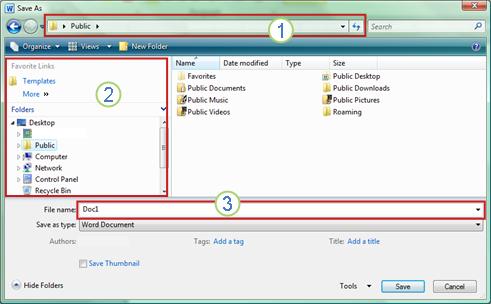
-
To choose a folder or type the path to a folder, use the Address Bar.
-
To quickly see locations you use often, use the Navigation pane.
-
To see more file types, click the arrow.
You can also use the Save As dialog box to rename a file or change the location of where you save the file by clicking a different folder.
You might want to save your file in another format so that you, or somebody else, can open the file in a different program or older version. For example, you might want to save your Word document as a Rich Text File (RTF) or your Excel workbook as a Comma-Separated Values (CSV) file.
-
Click the File tab.
-
Click Save As.
-
Choose a file location, such as OneDrive or This PC to store your file.
-
In the File name box, enter a new name for the file.
-
In the Save as type list, click the file format that you want to save the file in. For example, click Rich Text Format (.rtf), Web Page (.htm or .html), or Comma Delimited (.csv).
Note: For more information about how to save files in PDF (.pdf) or XPS (.xps) formats, see Save or convert to PDF or XPS.
-
Click Save.
If you are using Office 2010, you can save files in an earlier version of Microsoft 365 by selecting the version in the Save as type list in the Save As dialog box. For example, you can save your Word 2010 document (.docx) as a 97-2003 document (.doc).
Notes:
-
Office 2010 continues the use of the XML-based file formats, such as .docx, .xlsx, and .pptx, introduced in the 2007 Office release. Therefore, files created in Microsoft Word 2010, Microsoft Excel 2010, and Microsoft PowerPoint 2010 can be opened in the 2007 Office release programs without special add-ins or loss of functionality. For more information, see Open XML Formats and file name extensions.
-
For more information about compatibility between files from different releases, see Use the Compatibility Checker.
For information about saving Microsoft Access 2010 .ACCDB files into the older .MDB format see Convert an .accdb database to an earlier file format.
-
Click the File tab.
-
Click Save As.
-
In the File name box, enter a new name for the file.
-
Click Save.
When you use the Save As dialog box, you can also save the file to a new location by using the Navigation pane.

-
To choose a folder or type the path to a folder, use the Address Bar.
-
To quickly see locations you use often, use the Navigation pane.
-
To see more file types, click the arrow.
You can also use the Save As dialog box to rename a file or change the location of where you save the file by clicking a different folder.
You might want to save your file in another format so that you, or somebody else, can open the file in a different program or older version. For example, you might want to save your Word document as a Rich Text File (RTF) or your Excel workbook as a Comma-Separated Values (CSV) file.
-
Click the File tab.
-
Click Save As.
-
Choose a file location, such as OneDrive or This PC to store your file.
-
In the File name box, enter a new name for the file.
-
In the Save as type list, click the file format that you want to save the file in. For example, click Rich Text Format (.rtf), Web Page (.htm or .html), or Comma Delimited (.csv).
Note: For more information about how to save files in PDF (.pdf) or XPS (.xps) formats, see Save or convert to PDF or XPS.
-
Click Save.
If you are using Office 2010, you can save files in an earlier version of Microsoft 365 by selecting the version in the Save as type list in the Save As dialog box. For example, you can save your Word 2010 document (.docx) as a 97-2003 document (.doc).
Notes:
-
Office 2010 continues the use of the XML-based file formats, such as .docx, .xlsx, and .pptx, introduced in the 2007 Office release. Therefore, files created in Microsoft Word 2010, Microsoft Excel 2010, and Microsoft PowerPoint 2010 can be opened in the 2007 Office release programs without special add-ins or loss of functionality. For more information, see Open XML Formats and file name extensions.
-
For more information about compatibility between files from different releases, see Use the Compatibility Checker.
For information about saving Microsoft Access 2010 .ACCDB files into the older .MDB format see Convert an .accdb database to an earlier file format.
We’re listening
This article was updated January 29, 2020 as a result of your comments. If you found it helpful, and especially if you didn’t, please use the feedback controls below to let us know how we can make it better.
See Also
-
What is AutoSave?
-
Rename a file
-
Save or convert to PDF
-
Store, share, and sync your files
-
What happens when you sign out of Office
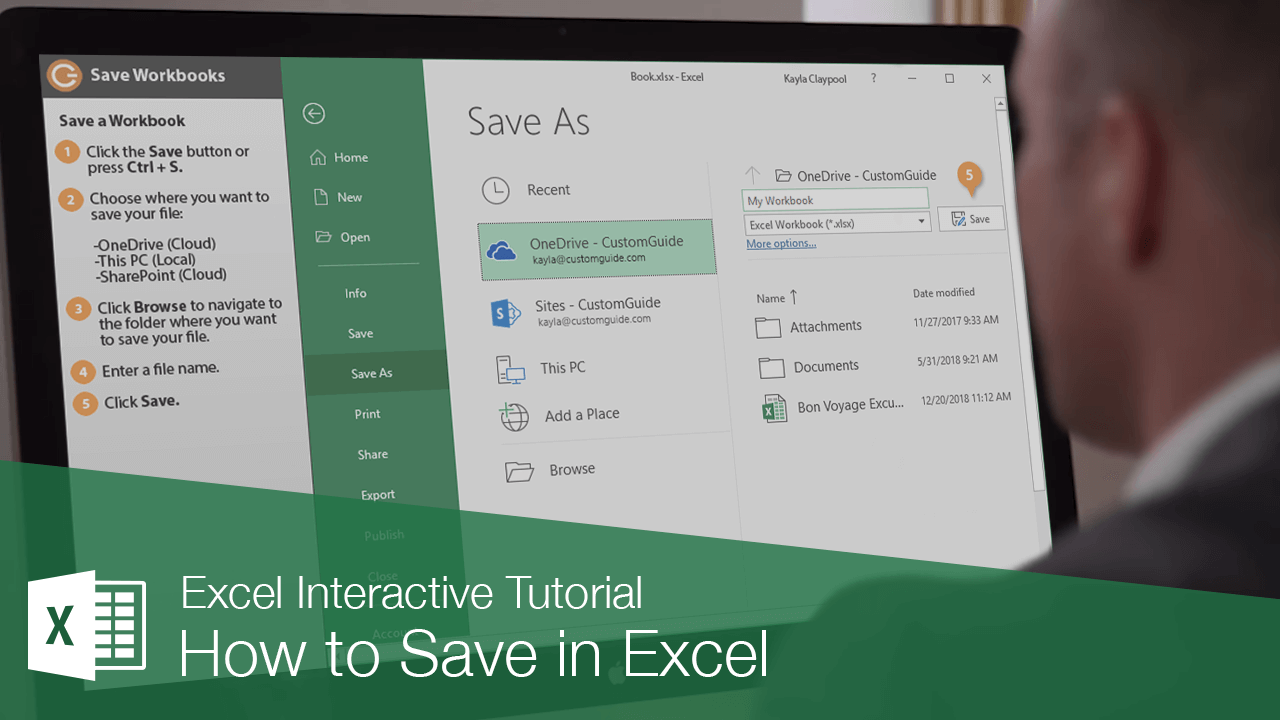
After you’ve created a workbook, you need to save it if you want to use it again. Also, if you make changes to a workbook you’ll want to save it. You can even save a copy of an existing workbook with a new name, to a different location, or using a different file type.
Save a Workbook
Once you’ve created a new workbook, you’ll need to save it if you want to use it again.
- Click the Save button.
Press Ctrl + S to quickly save a workbook.
If this is the first time you’ve saved the workbook, the Save As screen will appear.
- Choose where you want to save your file:
- OneDrive: Save to Microsoft’s cloud-based storage so you can open the worksheet on another computer.
- SharePoint: Save the workbook to a connected SharePoint server.
- This PC: Save to the local storage on your computer.
- Browse: Opens a dialog box, where you can browse through your computer’s folders, drives, and network shares.
- Enter a file name.
- Click Save.
AutoSave Workbooks
If an Excel file is saved online, the AutoSave feature in the top-left is automatically turned on. However, this can be changed as needed.
- Click the AutoSave toggle button to turn the feature on or off.
Save Progress
As you continue to work in Excel, you’ll want to save any changes you make from time to time.
- Click the Save button.
Press Ctrl + S to quickly save a workbook.
Try to save your progress every 10 minutes; that way you won’t lose any important changes if disaster strikes.
Save As a New File and/or Location
Sometimes you may want to make a copy of an existing workbook and save it with a new name. Using and modifying the content in an existing workbook can often save you a lot of time.
- Click the File tab.
- Click Save As.
- Click This PC to navigate to the folder you want to save your file.
- Enter a File name.
- Click Save.
Save to Different File Formats
Excel normally saves its files as Excel workbooks, but you can save information to other file formats as well. For example, sometimes you may want to save your data as a Comma Separated Values or CSV file, so you can import it into another program.
- Click the File tab.
- Click Save As.
- Click the Save as type list arrow.
The default file type is an XLSX Excel file, but you can choose from plenty of other file formats in this menu.
- Select the desired format.
- Click Save.
File Types Commonly Saved to From Excel
| File Type | Extension | Description |
|---|---|---|
| CSV | .csv | Comma delimited text file, often used to import/export data. |
| Excel Workbook | .xlsx | The default XLM-based file format for Excel, in use since Excel 2007. |
| Excel 97-2003 Workbook | .xls | Excel files from Excel 2003 and older. |
| Excel Macro-Enabled Template | .xlsm | Excel template that contains macros. |
| Excel Template | .xltx | Excel template files. |
| Portable Document Format, a format that preserves document formatting and allows file sharing. | ||
| Web Page | .html | A web page that is saved as a folder and contains an .htm file and supporting files, such as images. |
FREE Quick Reference
Click to Download
Free to distribute with our compliments; we hope you will consider our paid training.
Saving Files in Excel
Work should be saved regularly, even though Excel will save automatically as per the settings in the backstage SAVE area which can be accessed via the FILE OPTIONS menu or ALT, F, T. The keyboard shortcut most commonly used for saving is CTRL, S. This command overwrites the last version of the file saved.
The safest system when working on critical work, especially when the file is large, is to save multiple versions using the SAVE AS command. Press Browse, and a window will open for you to select the place where you want to save your worksheet.
The shortcut F12 is the fastest way to access this dialogue box:
Start a new search
To find content from modules and lessons
- Save as a copy: This option will create a copy of your file, and the original file will remain unchanged.
- Save as an Excel template: This option allows you to save the file with a new name and in a different format.
- Save as PDF or XPS: This will allow you to save the file in PDF or XPS format.
- Save as Image: If you are saving an image, this is the best option for you. It will allow you to save it in various formats such as JPEG, BMP, TIFF, PNG, etc.
The most common file type is .xlsx which is available to both Windows and Mac users. It has many advantages including being able to store larger datasets than its predecessor, the .xls file type. However, it also has some disadvantages such as not being able to use features like macros or conditional formatting on older versions of MS Excel or on Macs.
The default location for saved files in MS Excel is the user’s «My Documents» folder.
Learner’s Ratings
Reviews
Y
Yash kalra
I dont understood the quiz part the quiz is totally different from the video
S
Sunny kumar
This is a best learning app
K
Kajal Londhe
Best knowledge improve thank you so much
B
Brijesh Yadav
Really thankful to you to explain in such a lucent language
R
RESHMI KUMARI
its very useful for us
S
SHIVAM TIWARI
Formula wala pura uper ja rha
N
Navjeet Kaur
The theory is really good, but practice sheets must also be provided so that we can practice hand to hand. Excel is all about practice more than theory.
A
Aman kesarwani
Hi.
Please mujhe free mai certificate dedo please 😭😥🙏🙏
D
DABLOO Kumar
good and very suficient course
Show More
Being confident in how to save an Excel workbook, including save a copy and save as PDF, is a fundamental skill in Excel.
Once you have created a workbook (file), you will need to save the file in order to store it for later use. Saving a file means that you are storing the file into a storage area.
Examples of file storage areas are the hard disk in your PC, the network server, OneDrive, SharePoint, or a flash drive.
If you do not save a file, you will not be able to use the file later but will have to re-create it. Therefore it is a good option to save a file.
Saving your workbook for the first time
Any time a new workbook (a.k.a. a file) is created; Excel automatically gives it a default name of Book# to temporarily identify the file until you save it with a more appropriate name.
In the examples below a new workbook has been created and Excel has automatically given it the name Book1. This indicates it is the first workbook created since starting Excel. Until Excel is closed down all new workbooks will be named sequentially, e.g. the next new workbook during this session would be named Book 2.
Unsaved workbook
Compatibility Mode
When you see the words “Compatibility Mode” in the Title bar this indicated Excel is working in a mode compatible with old file formats.
In the example below the file is a .xls file, meaning the file is probably an old file created in an older version of Excel, e.g. Excel 97 up to Excel 2003.
Files created in Excel 2007 through to 2016 have a .xlsx extension, as shown in the example above for the “Saved workbook”. Working in Compatibility Mode, Excel will offer only a limited number of the features. If you like you can do a Save As and save the file as an ‘Excel Workbook’ which will upgrade it to the latest version.
Saved workbook
Compatibility Mode
To save your workbook
Step 1. To save your file do one of the following:
- From the File tab select Save or Save As
- Press CTRL + S
- Click the Save button on the Quick Access Toolbar
Step 2. Navigate to the folder the file will be saved into.
Step 3. In the File name box type the name you wish to give your file and then click Save.
Excel now saves the file and displays the name of the file in the Title Bar at the top of the screen.
Now continue to click Save each time you want to update the saved copy of your file with what you currently can see on your screen.
It’s a good idea to get into the habit of saving regularly!
Warning: please note that clicking Save TOTALLY OVERWRITES the existing saved file with any updates you have made since the last save. This is excellent if it’s what you want to do, not so great if you don’t want to update the file. If you would like to make a copy of a workbook, leaving the original untouched, do a Save As.
Use Save As to make a copy of your workbook
Save As allows you to save a file with a different name, to a different location or as a different file type.
Save As saves a copy of the open file, leaving the original file intact.
This is a helpful option to use when needing to create similar files with different details. It can save you from having to totally recreate a file.
Step 1. From the File tab select Save As or Save a Copy. Navigate to the folder the file will be saved to.
Step 2. You will see the existing name of the file in the File name box. This can be replaced with the name of the new document.
Note: if you are saving the file into a new folder you can keep the same name. However, if there is an existing file in the folder with the same name this isn’t a good idea as it will replace the original file with your file so be careful.
Step 3. Click Save.
Save your worksheet as a PDF
Microsoft Excel offers you the ability to save your document as a PDF, even if you don’t have PDF creation software loaded on your computer.
To do this:
Step 1: Select the worksheet you want to PDF.
Step 2: From the File tab select Save As or Save as Copy.
Step 3: Select the location for the saved file. In the Save As dialog box click the drop-down arrow for the Save as type list. Select PDF.
Note: this doesn’t secure the PDF for password security. If this is a requirement within your organisation please contact your administrator to find out the software you should be using to do this.
Was this blog helpful? Let us know in the Comments below.
Instructions
To save your workbook
- Save by either going to the File tab and selecting Save or Save As, pressing CTRL + S or clicking the Save button on the Quick Access Toolbar.
- Navigate to the folder the file will be saved into.
- In the File name box type the name you wish to give your file and then click Save.
Use Save As to make a copy of your workbook
- From the File tab select Save As or Save a Copy. Navigate to the folder the file will be saved to.
- You will see the existing name of the file in the File name box. This can be replaced with the name of the new document.
- Click Save.
Save your worksheet as a PDF
- Select the worksheet you want to PDF.
- From the File tab select Save As or Save as Copy.
- Select the location for the saved file. In the Save As dialog box click the drop-down arrow for the Save as type list. Select PDF.
Notes
Saving your workbook for the first time
Any time a new workbook (a.k.a. a file) is created; Excel automatically gives it a default name of Book# to temporarily identify the file until you save it with a more appropriate name.
Warning: please note that clicking Save TOTALLY OVERWRITES the existing saved file with any updates you have made since the last save. This is excellent if it’s what you want to do, not so great if you don’t want to update the file. If you would like to make a copy of a workbook, leaving the original untouched, do a Save As.
Compatibility Mode
When you see the words “Compatibility Mode” in the Title bar this indicated Excel is working in a mode compatible with old file formats.
Use Save As to make a copy of your workbook
Save As allows you to save a file with a different name, to a different location or as a different file type. Save As saves a copy of the open file, leaving the original file intact.
Note: if you are saving the file into a new folder you can keep the same name. However, if there is an existing file in the folder with the same name this isn’t a good idea as it will replace the original file with your file so be careful.
Save your worksheet as a PDF
Note: this doesn’t secure the PDF for password security. If this is a requirement within your organisation please contact your administrator to find out the software you should be using to do this.
If you enjoyed this post check out the related posts below.
Elevate your Excel game and become a pro with our exclusive Insider Group.
Be the first to know about new tutorials, videos, and tips for Microsoft 365 products. Join us now and claim your exclusive bonus today!
Lesson 4: Saving and Sharing Workbooks
/en/excel/creating-and-opening-workbooks/content/
Introduction
Whenever you create a new workbook in Excel, you’ll need to know how to save it in order to access and edit it later. As with previous versions of Excel, you can save files locally to your computer. You can also save a workbook to the cloud using OneDrive, as well as export and share workbooks with others directly from Excel.
Watch the video below to learn more about saving and sharing workbooks in Excel.
About OneDrive
Whenever you’re opening or saving a workbook, you’ll have the option of using your OneDrive, which is the online file storage service included with your Microsoft account. To enable this option, you’ll need to sign in to Office. To learn more, visit our lesson on Understanding OneDrive.
Save and Save As
Excel offers two ways to save a file: Save and Save As. These options work in similar ways, with a few important differences:
- Save: When you create or edit a workbook, you’ll use the Save command to save your changes. You’ll use this command most of the time. When you save a file, you’ll only need to choose a file name and location the first time. Then you can just click the Save command to save it with the same name and location.
- Save As: You’ll use this command to create a copy of a workbook while keeping the original. When you use Save As, you’ll need to choose a different name and/or location for the copied version.
To save a workbook:
It’s important to save your workbook whenever you start a new project or make changes to an existing one. Saving early and often can prevent your work from being lost. You’ll also need to pay close attention to where you save the workbook so it will be easy to find later.
- Locate and select the Save command on the Quick Access Toolbar.
- If you’re saving the file for the first time, the Save As pane will appear in Backstage view.
- You’ll then need to choose where to save the file and give it a file name. To save the workbook to your computer, select Computer, then click Browse. You can also click OneDrive to save the file to your OneDrive.
- The Save As dialog box will appear. Select the location where you want to save the workbook.
- Enter a file name for the workbook, then click Save.
- The workbook will be saved. You can click the Save command again to save your changes as you modify the workbook.
You can also access the Save command by pressing Ctrl+S on your keyboard.
Using Save As to make a copy
If you want to save a different version of a workbook while keeping the original, you can create a copy. For example, if you have a file named Sales Data, you could save it as Sales Data 2 so you’ll be able to edit the new file and still refer back to the original version.
To do this, click the Save As command in Backstage view. Just like when saving a file for the first time, you’ll need to choose where to save the file and give it a new file name.
To change the default save location:
If you don’t want to use OneDrive, you may be frustrated that OneDrive is selected as the default location when saving. If you find it inconvenient to select Computer each time, you can change the default save location so Computer is selected by default.
- Click the File tab to access Backstage view.
- Click Options.
- The Excel Options dialog box will appear. Select Save, check the box next to Save to Computer by default, then click OK. The default save location will be changed.
AutoRecover
Excel automatically saves your workbooks to a temporary folder while you are working on them. If you forget to save your changes or if Excel crashes, you can restore the file using AutoRecover.
To use AutoRecover:
- Open Excel. If autosaved versions of a file are found, the Document Recovery pane will appear.
- Click to open an available file. The workbook will be recovered.
By default, Excel autosaves every 10 minutes. If you are editing a workbook for less than 10 minutes, Excel may not create an autosaved version.
If you don’t see the file you need, you can browse all autosaved files from Backstage view. Just select the File tab, click Manage Workbook, then choose Recover Unsaved Workbooks.
Exporting workbooks
By default, Excel workbooks are saved in the .xlsx file type. However, there may be times when you need to use another file type, like a PDF or Excel 97-2003 workbook. It’s easy to export your workbook from Excel to a variety of file types.
To export a workbook as a PDF file:
Exporting your workbook as an Adobe Acrobat document, commonly known as a PDF file, can be especially useful if you’re sharing a workbook with someone who does not have Excel. A PDF will make it possible for recipients to view but not edit the content of your workbook.
- Click the File tab to access Backstage view.
- Click Export, then select Create PDF/XPS.
- The Save As dialog box will appear. Select the location where you want to export the workbook, enter a file name, then click Publish.
By default, Excel will only export the active worksheet. If you have multiple worksheets and want to save all of them in the same PDF file, click Options in the Save As dialog box. The Options dialog box will appear. Select Entire workbook, then click OK.
Whenever you export a workbook as a PDF, you’ll also need to consider how your workbook data will appear on each page of the PDF, just like printing a workbook. Visit our Page Layout and Printing lesson to learn more about what to consider before exporting a workbook as a PDF.
To export a workbook to other file types:
You may also find it helpful to export your workbook to other file types, like an Excel 97-2003 workbook if you need to share with people using an older version of Excel, or a .CSV file if you need a plain-text version of your workbook.
- Click the File tab to access Backstage view.
- Click Export, then select Change File Type.
- Select a common file type, then click Save As.
- The Save As dialog box will appear. Select the location where you want to export the workbook, enter a file name, then click Save.
You can also use the Save as type: drop-down menu in the Save As dialog box to save workbooks in a variety of file types.
Sharing workbooks
Excel makes it easy to share and collaborate on workbooks using OneDrive. In the past, if you wanted to share a file with someone, you could send it as an email attachment. While convenient, this system also creates multiple versions of the same file, which can be difficult to organize.
When you share a workbook from Excel, you’re actually giving others access to the exact same file. This lets you and the people you share with edit the same workbook without having to keep track of multiple versions.
In order to share a workbook, it must first be saved to your OneDrive.
To share a workbook:
- Click the File tab to access Backstage view, then click Share.
- Excel will return to Normal view and open the Share panel on the right side of the window. From here, you can invite people to share your document, see a list of who has access to the document, and set whether they can edit or only view the document.
Challenge!
- Open our practice workbook.
- Using the Save As option, create a copy of the workbook and name it Saving Practice Challenge. You can save the copy to a folder on your computer or to your OneDrive.
- Export the workbook as a PDF file.
/en/excel/cell-basics/content/
Use Excel Shortcut Keys to Quickly Save Your Work
Save early, save often!
Updated on December 2, 2020
You’ve put a lot of work into your Excel spreadsheet, don’t let it slip away because you forgot to save it. Use these tips to keep your work safe and saved for the next time you need that important file. When you want to share your work, save the workbook in PDF format.
Instructions in this article apply to Excel 2019, 2016, 2013, 2010; Excel for Microsoft 365, and Excel for Mac.
Use Excel Save Shortcut Keys
There are three ways to save a file in Excel:
- Select File > Save As. In Excel 2019, select File > Save a Copy.
- Select Save on the Quick Access Toolbar.
- Use the Ctrl+S shortcut key.
If you work on a Mac, use the Command key instead of the Control key.
If the file has been saved before, the pointer changes to an hourglass icon while the save takes place. If the workbook is being saved for the first time, the Save As dialog box opens.
First Time Save
When a file is saved for the first time, two pieces of information must be specified in the Save As dialog box. Enter a name for the file and choose the location where it will be saved.
File names can contain up to 255 characters including spaces.
Save Frequently
Using Ctrl+S is an easy way to save data. Use this shortcut frequently, at least every five minutes, to avoid losing data.
Pin Save Locations
If you open certain files or folders frequently in Excel, pin them to your list of recently opened files. This keeps the location readily accessible at the top of the Recent list.
There is no limit to the number of locations that can be pinned. To pin a save location:
-
To pin a folder, select File > Save As.
-
Select Recent and, on the right side of the window, hover over the workbook or folder you want to pin. A small horizontal image of a push pin appears for that location.
-
Select the pin for that location. The folder is moved to the Pinned list and the horizontal push pin changes to a vertical push pin.
-
To unpin a location, select the vertical push pin to change it back to a horizontal pin and remove it from the Pinned list.
Save Excel Worksheets as PDF Files
When you want a copy of a worksheet or an entire workbook that nobody can edit and everyone can view, convert or save your Excel files in PDF format. A PDF file (Portable Document Format) allows others to view documents without needing the original program, such as Excel, installed on their computer. Instead, users open the file with a free PDF reader program such as Adobe Acrobat Reader.
Saving the Active Worksheet in PDF Format
When saving a file in PDF format, by default only the current, or active worksheet (the worksheet on screen), is saved.
To save an Excel worksheet in PDF format:
-
Select File.
-
Select Save As to open the Save As window.
-
Choose the location where you want to save the file.
-
Enter a name for the file.
-
Select the Save as type down arrow.
-
Scroll through the list to find and select PDF (*.pdf).
-
Select Save to save the file in PDF format and close the window.
Save an Entire Workbook in PDF Format
The default Save As option only saves the current worksheet in PDF format. Follow these steps to save your entire workbook as a PDF file:
-
Select File > Save As.
-
Select Browse to open the Save As dialog box.
-
Select Save as type to open a drop-down list and choose PDF. The Options button appears in the Save As dialog box.
-
Select Options to open the Options dialog box.
-
Select Entire Workbook in the Publish what section.
-
Select OK to return to the Save As dialog box.
-
Select Save to save the workbook in PDF format and close the dialog box.
AutoSave to OneDrive
If you use Microsoft 365, Excel automatically saves your work when you choose to save files to your OneDrive cloud storage account. When your files are saved to OneDrive, documents are automatically saved every few seconds, eliminating the need for you to continuously select Save or use shortcut keys.
For the AutoSave function to work, save documents to a location in your OneDrive folder. The AutoSave function does not work with any location on your PC or Mac.
If you have Microsoft 365 and save your files to OneDrive, enable AutoSave by selecting the toggle switch in the top-left corner of the Excel screen. When enabled, the switch will say On. To turn the feature off and save your work manually, change it to Off.
Thanks for letting us know!
Get the Latest Tech News Delivered Every Day
Subscribe
While Excel has been continuously improved with each new version, there are still times when you may find it crashing once in a while (especially if you’re working with a large dataset).
And sometimes, it could be a factor outside of Excel – such as a power failure or your system hanging because of an issue other than Excel.
In such cases, to make sure you don’t lose your data, Excel has an AutoSave feature – which as the name suggests, will automatically save your work.
With autosave enabled, Excel will save your work at regular intervals, which will make sure you don’t lose a lot of your work (at max a few minutes of work can be lost).
In this tutorial, I will show you how to turn on AutoSave in Excel and all the important things you need to know about it.
Note: AutoSave is a new feature in Office365, where it allows you to save real-time when files are saved in OneDrive or SharePoint. In case you’re using prior versions (Excel 2010/2013/2016/2019), you have the Save AutoRecover Information, which is not real-time but saves your work at regular intervals.
AutoSave Vs AutoRecover
AutoSave is a new feature in Excel Office 365, while AutoRecover has been in prior versions as well.
AutoSave allows you to save your work in real-time when you save your Excel files in OneDrive or SharePoint.
On the contrary, ‘Save AutoRecover Information’ is an option that automatically saves your work every 10 minutes (or whatever time period you specify). With this option enabled, it will keep a temporary copy of your work and keep saving it every 10 minutes.
In case your system shuts down unexpectedly, you will still be able to recover the temporarily saved file (using the Autorecover feature).
In this tutorial, I will cover both of these features.
Turn On AutoSave in Excel from the Options Dialog box
You can enable AutoSave as well as save auto-recover information (i.e., to save files automatically at a certain time interval) in Excel from the Options dialog box. Once done, this would be turned on for all the workbooks you work on that system.
Remember that AutoSave is only available for Office365 users. If you don’t have O365, you can only use AutoRecover.
Below are the steps to turn on Auto-save in Excel:
- Click the File tab
- Click on Options
- In the Excel Options dialog box, click on the Save option on the left
- Check the option – ‘Save AutoRecover information every’ checkbox. By default, the value is 10 minutes, but you can choose a lower or higher value if you want.
- Check the Option – “AutoSave OneDrive and SharePoint Online files by default in Excel’. This option works for Office 365 only and saves your work in real-time (every few seconds)
- Click Ok
The above steps would make sure that your work is automatically saved after every 10 minutes.
Note that for ‘AutoSave OneDrive and SharePoint Online files by default in Excel’ to work, your files need to be in the latest file format (i.e., XLSX and not XLS).
Other useful options you can use:
When AutoSave is enabled (with files saved on Onedrive or SharePoint), you won’t see a prompt to save unsaved changes when you close the file (since these changes are being saved every few seconds).
Also, in case you’re adding a VB Code (macro) to the File, AutoSave would stop and will show you a prompt to save this file as a Macro-enabled fike (.xlsm format)
AutoSave now enables Excel users to share files and make changes in real-time. Also, you can see the version history and go back to any previous version if you want. When you open an old file using version history, it will be opened as Read-Only and you can save it with a new name if you want.
Adding AutoSave to QAT (for Office 365)
If you’re using OneDrive or SharePoint, you can also add the AutoSave option in the Quick Access Toolbar (available only in Office 365).
This allows you to enable autosave (in SharePoint or OneDrive) with a single click (it’s a toggle button).
While I found it to be available by default in my Office365 subscription, in case you don’t have it, you can add AutoSave to the Quick Access Toolbar using the below steps:
- Click on the Customize Quick Access Toolbar icon
- Click on Automatically Save option
In case you don’t see the ‘Automatically Save’ option in the drop-down, click on More Command and use the Excel Options dialog box to add the AutoSave option in the QAT.
An issue with AutoSave (Save As vs. Save a Copy)
When you enable AutoSave and save the file in OneDrive or SharePoint, you will notice that you no longer see the ‘Save as’ option. Instead, you see the ‘Save a Copy’ option (more on this here)
When AutoSave is enabled and your work is being saved every few seconds, it won’t be possible to make some changes and save it as a new file.
For example, if you start with an old file, work on it for 20 minutes and save a copy, you will have the old file as well as the new file with 20 minutes of latest work. But this isn’t possible with AutoSave enabled where it’s saving your work every few seconds.
This is why you now have the ‘Save a Copy‘ option, which you can use to create a copy and then make the changes.
In case your Excel files are not on OneDrive or SharePoint, you will still see the ‘Save As’ option.
Using Third-Party Tools such as DropBox or Google Drive
You can also get the version history options for Excel files with storage options such as Dropbox and Google Drive.
These tools simply check if there have been any changes in the file and save the prior version. You can then go back to these versions if you want.
One of the benefits of using these third-party tools is that you can easily collaborate with people who don’t use OneDrive.
Since Google Drive and Dropbox are usually preferred over OneDrive by many, this helps when you’re working with teams/clients who use these options.
The only caveat is to make sure you don’t keep confidential data on these cloud storage services.
Automatically Save File Before Closing using VBA
AutoSave is an amazing feature and makes working with Excel a lot stress-free – knowing that the data won’t be lost.
In case you don’t have Office 365 (which means you don’t have the AutoSave feature as well), you will have to rely on Excel’s AutoRecover feature.
Another option you can use is by having a simple VBA code in place that makes sure that your file is saved before you close it. This ensures you don’t lose your work because you closed the file before saving it.
Note: Using this would make sense only if you’re not using Office 365 with OneDrive or SharePoint. If you are, you can always go back to previous versions and your files are saved automatically anyway.
Below are the steps use VBA to save a file before closing the workbook:
- Open the workbook where you want to enable this VBA code to save before close.
- Hold the ALT key and press the F11 key (or Command + Option + F11 in Mac). This opens the VB Editor.
- Double-click on the ThisWorkbook object (for the file where you want to add this code) in the Project Explorer
- Copy and Paste the below code in the ThisWorkbook code window:
Private Sub Workbook_BeforeClose(Cancel As Boolean) ThisWorkbook.Save End Sub
- Close the VB Editor
Now, when there is any change in the workbook and you close it before saving, it will first run this code (as this is a VBA Event that runs based on an event – which is workbook closing in this case). This code will first save the workbook and then close it.
In case you haven’t saved the file before, this will show a prompt that will ask you to specify the location where the file should be saved.
In case you don’t want to overwrite your existing file, you can also modify the code so that it saves the file with a timestamp. This way, your work is not lost, and you can also go back to a previous version.
Below is the VBA code that will save the file with the date and time-stamp in the filename:
Private Sub Workbook_BeforeClose(Cancel As Boolean) wbname = ThisWorkbook.Name timestamp = Format(Now, "ddmmmyyy-hhmmss") ThisWorkbook.SaveAs timestamp & wbname End Sub
This will save the new file with a timestamp in the name in the same location where the old file is saved. If you want the file to be saved in a specific folder, you can specify that location in the code.
So this is all that you should know about enabling AutoSave in Excel and using it efficiently. And if you’re not using Office 365 and hence don’t have AutoSave, you can still configure the AutoRecover options and recover any unsaved files. Also, the VBA code can be used to make sure the files are saved as a copy automatically when you close it.
Hope you found this tutorial useful!
You may also like the following Excel tutorials:
- How to Reduce Excel File Size
- Split Each Excel Sheet Into Separate Files
- How to Automatically Open Specific Excel File on Startup
- Get a List of File Names from Folders & Sub-folders (using Power Query)
- Microsoft Excel Won’t Open; How to Fix it!
“Save As” is located in the file tab of the worksheet in Excel. Still, there are also some keyboard shortcuts for using it. One is on the Quick Access Toolbar, or we can press F12 and display the save as option or press the keyboard shortcut CTRL+S, which opens the “Save As” dialog box to save the file in the desired format path.
For example, If you add the “Save As” option to your Quick Access Toolbar, you may move aimlessly over the icon to see its keyboard shortcut. e.g., Alt+H keyboard shortcut to open the Home tab.
Save and Save As: Both shortcuts belong to Excel’s “File” class functions. “Save” and “Save As” shortcut keys in Excel save the temporary data in Excel to an Excel file.
“Save” and “Save As” Shortcuts in ExcelAn Excel shortcut is a technique of performing a manual task in a quicker way.read more are the most important functions as they enable the user to save the data created in Excel. Without these functions, the user may lose the data that has been made in Excel once the file is closed. So, one must understand these functions clearly.
- The “Save As” shortcut key in Excel differs from the “Save” shortcut in Excel. The “Save As” function enables users to store the data in a separate file or even in an independent format from the original structure.
- It was introduced when it observed that the user loses the original file once the changes are saved in the file. The “Save As” shortcut function in Excel enables users to save the changes made in the primary file in a new file. Using the “Save As” function, the user can keep the file in the same format, with a different name, or even at a different location.
- So, Excel’s “Save As” shortcut function offers more functionality than Excel’s traditional “Save” function.
Table of contents
- Excel Shortcut: “Save As”
- Save As Shortcut in Excel Examples
- How to Use the “Save As” Shortcut in Excel?
- Method #1 – Using the Excel Keyboard Shortcut for “Save As”
- Method #2 – Add the “Save As” Function to the Quick Access Toolbar in Excel
- Method #3 – Adding “Save As” Option to the Ribbon in Excel
- Method #4 – Use VBA as a “Save As” Shortcut
- Explanation of “Save As” Function in Excel
- Things to Remember About “Save As” Shortcut in Excel
- Recommended Articles
Save As Shortcut in Excel Examples
Add the “Save As” function to the ribbon.
- Using the “Save As” shortcut key in Excel – F12
- Add the “Save As” function to the Quick Access Toolbar.
- Add the “Save As” function to the ribbon.
- Using VBA
How to Use the “Save As” Shortcut in Excel?
Below are the four methods of using Excel’s “Save As” shortcut.
Method #1 – Using the Excel Keyboard Shortcut for “Save As”
Step 1 – Make sure that no undoing of actions is required.
Before saving the file, one should ensure that no action performed needs an undo. If it requires undoing, one must first undo the action and then only can save the changes.
Step 2 – Use the keyboard Excel shortcut key “F12” to open the “Save As” dialog box.
Step 3 – Please choose a new file name, type, and location where you want to save the file.
Method #2 – Add the “Save As” Function to the Quick Access Toolbar in Excel
Step 1 –
Go to the Quick Access ToolbarQuick Access Toolbar (QAT) is a toolbar in Excel that may be customized and is located on the upper left-hand side of the window. It enables users to save important shortcuts and easily access them when needed.read more and click on the little “dropdown” key.
Step 2 –
From the options, choose the option “More Commands.”
Step 3 –
Choose “All Commands” from the menu and add the “Save As” function to the Quick Access Toolbar.
Step 4 –
After adding the “Save As” function, we can use it with a single click.
Method #3 – Adding “Save As” Option to the Ribbon in Excel
One can also add the “Save As” function to the ribbon.
Step 1 –
Click on “File” and choose “Options” from the menu.
Step 2 –
Choose all commands from the customize ribbon tab, search for the “Save As” function, and add that to the ribbon.
Step 3 –
After the “Save As” function is added to the ribbon, it will appear below.
Method #4 – Use VBA as a “Save As” Shortcut
VBA can also be used as a shortcut for “Save As” by using the code.
Activeworkbook means active Excel.
Save As is the “Save As” function that must be executed.
“Save this as this name” and enter the name by which the file has to be saved.
Explanation of the “Save As” Function in Excel
Whenever we work on a spreadsheet shared between teammates, then it becomes essential that the other team members should not edit the primary file. For example, suppose there is a situation where the team manager has created a file and shared the file with the teammates. Some teammates have altered the formulas as per their needs and saved the changes in the file.
In such a situation, it will create a problem for the user who has made the primary file, as the teammate’s changes are already saved in the same file. Furthermore, restoring the changes and recovering the original file is impossible. So, to take care of both situations, we use Excel’s “Save As” function to save the changes and keep the primary file.
- Excel’s “Save As” function allows the user to save the changes by a new file name and enables the user to change the file type and location where the file has been saved.
- Using the “Save As” function, the user can create the file with a new location and a new file type. However, sometimes the user needs to save a file as a “PDF,” and sometimes they must change the file type to a macro-enabled worksheet. Therefore, it becomes essential that the user has some inbuilt option in such cases. Hence, we have the “Save As” function in Excel.
- So, whenever we want to save the changes and the primary file, use the “Save As” function. There are many ways to add shortcuts for the “Save As” function.
- We can use the keyboard shortcut key combinations and add these “Save As” functions in the ribbon or the quick access toolbar. Using the “Save As” shortcut key will enable a user to reduce the time saving the file with conventional methods. Moreover, we also have the VBA code that one can easily use to execute the “Save As” shortcut key in Excel.
Things to Remember About “Save As” Shortcut in Excel
- We must enter a unique name when using the “Save As” shortcut in Excel. Otherwise, we will get a warning message that “filename exists,” If we accidentally override the warning and hit the save button, the old file will get replaced. Hence, we will lose the primary file.
- If we used VBA code in ExcelVBA code refers to a set of instructions written by the user in the Visual Basic Applications programming language on a Visual Basic Editor (VBE) to perform a specific task.read more, we must use the Excel extensionExcel extensions represent the file format. It helps the user to save different types of excel files in various formats. For instance, .xlsx is used for simple data, and XLSM is used to store the VBA code.read more “.xlsm” while using the “Save As” shortcut in Excel.
- If we want to save the file with the same name as the primary file, we should change the file’s location while doing the “Save As” shortcut in Excel.
Recommended Articles
This article is a guide to Save As Shortcut in Excel. Here we discuss the keyboard shortcut of Save and Save As, including 4 different Excel methods (the F12 function, using the quick access toolbar, adding it in ribbon, and creating a shortcut in VBA). You may learn more about Excel from the following articles: –
- Age Calculation in Excel
- Using a Shortcut key to Merge Cells in Excel
- Compare Two Excel Columns
- Unmerge Cells in Excel
Excel AutoSave (Table of Contents)
- AutoSave in Excel
- How to Enable AutoSave in Excel?
AutoSave in Excel
Excel provides a very powerful tool to enable AutoSave a workbook in Excel. It helps to protect our workbook in case of Power failures, closed excel without saving it, or something happens, which was totally unexpected.
When we enable AutoSave mode in Excel, we can save our workbook file in a gap of every 10 minutes. It will happen periodically. As per our requirement, we can change as per our requirement, let us take an example, suppose if we are working on something that is very important and wants to reduce the time to 1 min. So, there is no need to worry about losing data due to any problem rather; we will lose very minimal data instead of losing it completely.
Shortcuts to Save the Excel file: We can use Ctrl + S shortcut to save the workbook manually.
How to Enable AutoSave in Excel?
AutoSave in Excel helps us to protect our files in case of a system crash. It is also useful when we accidentally close the working file.
Let’s understand How to Enable AutoSave in Excel with some examples.
Example #1
Enable AutoSave in Excel:
A user has a standalone book data of sales, income, PBDIT, and Profit details of each quarter of ABC Company.
Step 1: Open Excel and Click on the File tab.
Step 2: Now click on Options.
Step 3: After clicking on Options, a pop-up will open with a header as Excel Options; click on the Save.
Step 4: Now AutoSave setting will be open where a user can configure AutoSave settings, tick mark on the AutoSave checkbox, configure the time at which time interval you want to save the workbook for AutoRecover, and select the respective file where you want to save the file. Then click on the OK button; all the settings will be applied to the workbook.
Summary of Example #1:
As we can see in the above example of an Excel AutoSave, a user can configure the time at which time interval you want to save the workbook for AutoRecover and select the respective file where you want to save the file.
Now a user can work without losing data that might happen due to an excel crash or any system issue. AutoSave will save the data to the user’s located path, and he can recover the data as per requirement.
Example #2
How to enable Excel AutoSave and save maximum work from losing it due to some power failure or something unexpected happening in Excel.
A user has a standalone book data of sales, income, PBDIT, and Profit details of each quarter of ABC Company.
Step 1: Open MS Excel and Click on the File tab.
Step 2: Now click on the Options.
Step 3: After clicking on Options, one pop-up will be open with the header Excel Options, click on the Save.
Step 4: Now AutoSave setting will be open where a user can configure AutoSave settings, tick mark on the AutoSave checkbox, configure the time at which time interval you want to save the workbook for AutoRecover, and select the respective file where you want to save the file.
Step 5: Now select the Keep the last AutoRecovered version if I close without saving box to save the last saved file for the auto-recovered. Then click on the OK button; all the settings will be applied to the workbook.
Summary of Example #2:
As we can see in the above example of an Excel AutoSave, a user can configure the time at which time interval you want to save the workbook for AutoRecover and select the respective file where you want to save the file. When a user recovers the file from the saved file, the last version of the saved workbook will be open if you closed without saving it.
Now a user can work without any tension of losing data due to an excel crash or any system issue. AutoSave will save the data to the user’s located path, and he can recover the data as per requirement.
Example #3
How to save the backup file to your choice of folder?
Let’s take the same data for this example.
Step 1: Open Excel and Click on the File tab.
Step 2: Now click on Options.
Step 3: After clicking on Options, one pop-up be open with a header as Excel Options click on Save.
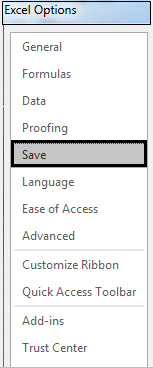
Step 4: Now AutoSave setting will be open where a user can configure AutoSave settings, tick mark on the AutoSave checkbox, and configure the time interval you want to save the workbook for AutoRecover and select the respective file where you want to save the file.
Step 5: Now select the Keep the last AutoRecovered version if I close without saving box to save the last saved file for the auto-recovered.
Step 6: Now select the box Save to computer by default option, provide your default local path.
Step 7: Now click on the OK button, and all the settings will be applied to the workbook.
Summary of Example #3:
As we can see in the above example of an Excel AutoSave, a user can configure the time at which time interval you want to save the workbook for AutoRecover and select the respective file where you want to save the file. When a user is about to recover the file from the saved file, the last version of the saved workbook will be open if you have closed without saving it. It will save all our backup files in the local path given in the default file location, which is C:Backup Files.
Now a user can work without any tension of losing data due to an excel crash or any system issue. AutoSave will save the data to the user’s located path, and he can recover the data as per requirement.
Things to Remember
- If a user is given AutoSave time of 15 minutes in the AutoSave configuration settings, it will save the data after every 15 mins.
- Another side of point 1, If you want to increase your workbook performance, then just increase the AutoSave time to time digits like 20 Min, 25 Min, etc.
- Always try to keep a lesser or small number for AutoSave time like 4 min, 5 min, etc., so that you can save data more frequently.
- If you are not enabling AutoSave mode in Excel, then make sure you are saving your workbook more frequently.
- If you are saving your file to one drive or share point and using the latest version of Excel, you will find a button on the top left of Excel, which will automatically save your data every few seconds.
Recommended Articles
This has been a guide to AutoSave in Excel. Here we discussed AutoSave in Excel and How to Enable AutoSave in Excel, along with practical examples. You can also go through our other suggested articles –
- Unprotect Sheet in Excel
- Copy Excel Sheet
- Paste Shortcut Option in Excel
- Check mark in Excel

 on the Quick Access Toolbar.
on the Quick Access Toolbar.